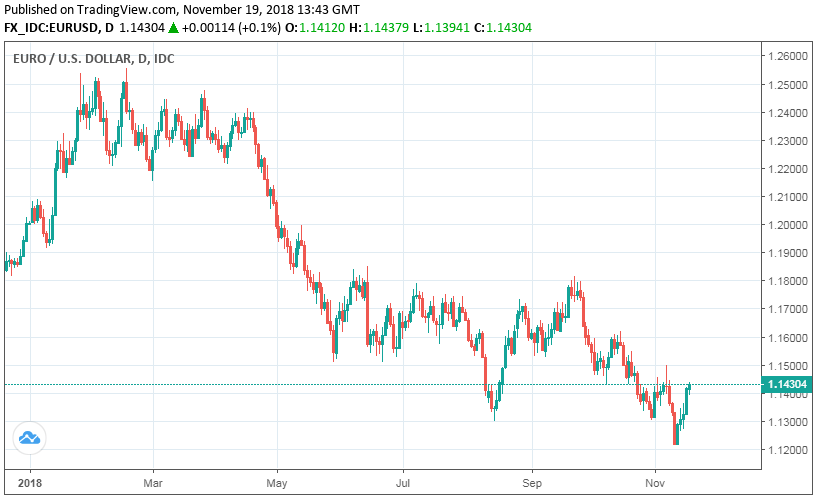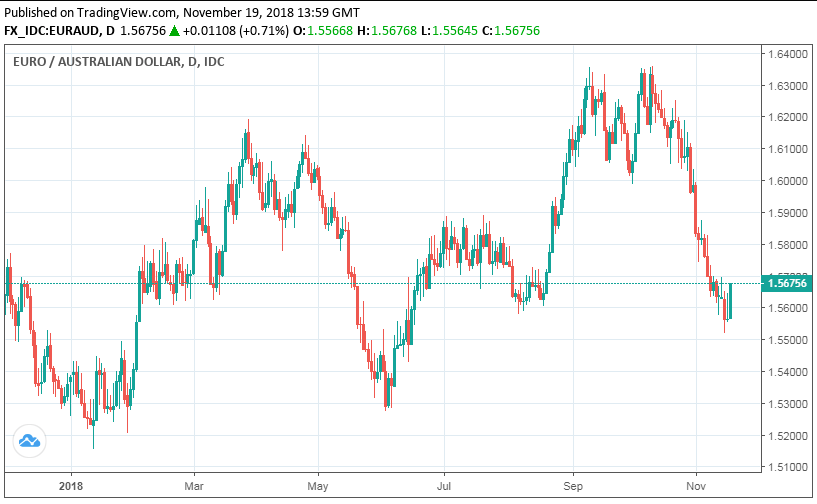EUR/USD Bounce Eyes Make-or-Break Test at 1.15
- Written by: James Skinner

© European Central Bank
- EUR/USD rebound to fizzle out ahead of the 1.15 level says ING.
- EUR/AUD to decline as investors use EUR as "funding currency".
- ECB policy outlook darkened by concern over growth and Italy.
The Euro entered the new week on the offensive Monday, advancing against the Dollar and most other developed world currencies, but the FX strategy team at ING Group say the rebound will soon fizzle out.
Europe's single currency caught a breather late last week due to a weakening of the Dollar, which has softened after a series of Federal Reserve (Fed) policymakers expressed concern about the impact that global financial market volatility could have on the U.S. economic and interest rate outlooks.
Yet, the headwinds that had driven the Euro to a fresh 18-month low during the previous week continue to loom large over the currency. And those challenges are only likely to remind investors of the Euro's shortcomings, potentially leaving it clutching at straws for support as soon the nascent Dollar correction is over.
"The slightly softer dollar has allowed a modest bounce, but we expect this to fade well ahead of 1.1500. In fact the EUR should increasingly be seen as a funding currency and after last week’s break-out in this year’s AUD/USD bear trend, we expect short EUR/AUD positions to prove popular for the short term," says Chris Turner, head of currency strategy at ING Group.

Above: Euro-to-Dollar rate shown at daily intervals.
1.15 is a make-or-break level that many in the market are watching because a move above here would suggest the trend is turning in favour of the single currency once more.
"With EUR/USD ratcheting toward a test of resistance around the 1.1440 mark we think a clear break above 1.15 would signal a durable change in trend. Ultimately, however, any rally will need validation from a similar move higher in (real) bund yields," says Ned Rumpeltin, European Head of FX Strategy with TD Securities.
Most analysts are unconvinced bund yields will gain any significant traction in the current environment of ultra-easy European Central Bank (ECB) policy though.
ECB interest rates remain at record lows, with the deposit rate in negative territory and the benchmark lending rate at 0%, and there is little chance of this changing any time soon.
Meanwhile, the continental economic outlook has clouded in recent weeks after official data showed growth falling by half in the third-quarter, while the German economy contracted for the first time since 2015.
The European Commission and Italian government also remain on a collision course over the latter's 2019 budget proposals. Italy's ongoing clash with the EU has already rocked the Euro repeatedly in recent months due to the impact it has had on the Italian bond market and given related fears about the long-term viability of the currency union.
"The European economy faces a range of risks in 2019 that could make the outcome worse than we expect. Italy’s budget crisis remains unresolved and we expect the Italian economy to flirt with recession early next year," says Jan Hatzius, chief economist at Goldman Sachs, in a recent breifing to clients.
Neither of these things will bring forward the point at which the European Central Bank can begin lifting its interest rate from crisis-era levelsm, which is key to engineering a durable recovery from what are the lowest levels seen by the single currency since June 2017.
This means that, in the current environment where a previously-resurgent Dollar is softening again, the very last destination bond investors are likely to look to reallocate money toward is the Eurozone. Turner highlights the EUR/AUD rate as one of the most likely casualties of the new soft-Dollar paradigm in markets. And he's not the only one either.

Above: Euro-to-Australian-Dollar rate shown at daily intervals.
"We think there is room for a rebound," Kamakshaya Trivedi, global co-head of foreign exchange at Goldman Sachs, in a client note detailing the bank's best investment ideas. "We recommend funding the trade out of EUR, where a confluence of political risks and growth concerns is likely to cap performance over the next few months and carry is attractive."
Trivedi and the Goldman Sachs team recommended last week that clients of the bank bet on a fall in the EUR/AUD rate over coming months, due largely to bilateral interest rate dynamics that are disadvantageous to the single currency.
ECB policy means investors can borrow Euros on the cheap and use them to buy 'higher yielding' currencies like the Australian Dollar. But doing this requires investors to sell Euros on the market and buy Dollars, and so would be likley to lead a decline in the above exchange rate.
Australia's main interest rate, although also at a record low, is at 1.5% and a full 150 basis points above the equivalent Eurozone rate. With the ECB, at best, unlikely to change its policy until the end of 2019 the rate EU-AU differential is set to remain at 150 basis points or more for a while yet.
"Our forecasts imply a fairly broad-based turn to higher rates across most DM economies, with Sweden, Australia, New Zealand, and (in our baseline forecast) the Euro area joining the US, UK, Canada, and Norway in lifting their policy rates," Trivedi writes.
The Euro was quoted 0.17% higher at 1.1426 against the Dollar Monday but is down -4.7% for 2018, while the EUR/AUD rate was up 0.74% at 1.5660 and has risen 2.2% this year.
Advertisement
Bank-beating exchange rates. Get up to 5% more foreign exchange by using a specialist provider to get closer to the real market rate and avoid the gaping spreads charged by your bank when providing currency. Learn more here




